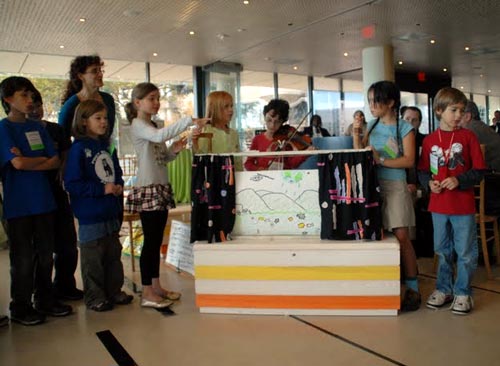To join an ad hoc committee of the National Capital Region Organics Task Force that is supporting the adoption of policies and standards that promote compost-amended soils as watershed protection, email Bobby Bell info@ilsr.org.
Background
Naturally occurring (undisturbed) soil and vegetation provide important stormwater functions including: water infiltration; nutrient, sediment, and pollutant adsorption; sediment and pollutant biofiltration; water interflow storage and transmission; and pollutant decomposition. These functions are largely lost when development strips away native soil and vegetation and replaces it with minimal topsoil and sod. Incorporating compost to establish a minimum soil quality and depth will provide improved onsite management of stormwater flow and water quality.
The level of organic matter is vital to soil quality. Amending soil with compost is the best way to increase the organic matter in soil. Compost has a high percentage of organic matter (40 to 60%), which allows soil to retain water. Compost can hold up to 20 times its weight in water. Compost can increase the ability of soil to store water by 16,000 gal/acre ft for each 1% of organic matter added. Benefits of promoting soil best practices are better erosion control; reduced stormwater runoff (with better water quality as compost acts as a natural filter for pollutants such as heavy metals, nitrogen, phosphorus, fuels, grease and oil); and healthier landscapes that require less water, fertilizer, and pesticides.
Using Washington state’s Soils for Salmon initiative as a model, the Organics Task Force has agreed to promote minimum soil quality and depth standards and amending soils with compost to improve stormwater management in the DC area and protect the Chesapeake Bay watershed. For more information on the soil-watershed connection and the importance of building healthy soils with compost, see ILSR’s report: Building Healthy Soils with Compost to Protect Watersheds.
ILSR has spearheaded this work in the past year. Key presentations, meetings, and reports are described below.
May 2012 – David McDonald, Seattle Public Utilities, presented to the Organics Task Force on the value of diverting organics and using compost in green infrastructure as part of the Soils for Salmon project in Washington state. See “Green Infrastructure – How to Institutionalize Organics Diversion & Compost Use through local/state & government/business collaboration.”
October 2012 – Brenda Platt, ILSR, presented to the MD State Highway Administration’s Recycled Materials Task Force on the benefits of using compost as a soil erosion control measure. See “Controlling Roadway Soil Erosion with Compost.”
May 2013 – Release of ILSR report Building Healthy Soils with Compost to Protect Watersheds – This 12-page report highlights the importance of organic matter to healthy soils, and links healthy soils in turn to a healthier watershed.
March 2013 – “Compost BMP’s – EPA-WIP/TMDL Challenge Seminar,” Annapolis, Maryland – This seminar hosted by Filtrexx International and Spa Creek Conservancy and co-sponsored by ILSR focused on how compost-based best management practices can dramatically reduce sediment and targeted pollutants entering the Chesapeake Bay and its tributaries. See presentation “MD Drivers For Compost Use & Focus On Controlling Roadway Erosion With Compost” by Brenda Platt, ILSR.
November 2012 – “Compost: Protecting Our Watershed” roundtable session facilitated by Brenda Platt, ILSR, at the Alice Ferguson Foundation 7th Annual Trash Summit – This session explored how compost can improve our watershed’s water quality, identified opportunities to adopt compost as a best management practice, and discussed how to incorporate compost into policy.
Roundtable Session Notes
Dr. Greg Evanylo Presentation – “Environmental Benefits of Using Compost in Urban Landscapes”
Ann English Presentation – “Compost: Part of the RainScapes Strategy for Reducing Runoff and Improving Water Quality”
David McDonald Presentation – “Green Stormwater Infrastructure: Putting Compost to Work in Washington’s Soils for Salmon Initiative”
Resource Links:
Building Healthy Soils with Compost to Protect Watersheds – This 12-page report highlights the importance of organic matter to healthy soils, and links healthy soils in turn to a healthier watershed.
Washington state’s Soils for Salmon Project – Soils for Salmon is a project promoting the conservation of native soils and improvement of disturbed soils (which uses compost to increase soil organic matter) to preserve the waterways and aquatic life in Washington state.
The Sustainable Sites Initiative – The Sustainable Sites Initiative™ (SITES™) is an interdisciplinary effort by the American Society of Landscape Architects, the Lady Bird Johnson Wildflower Center at The University of Texas at Austin and the United States Botanic Garden to create voluntary national guidelines and performance benchmarks for sustainable land design, construction and maintenance practices.
Montgomery County, MD RainScapes Program – RainScapes promotes and implements projects on residential, institutional, and commercial properties to reduce stormwater pollution through a rebate program.
Washington, DC RiverSmart Homes Program – Similar to RainScapes in Montgomery County, the RiverSmart Homes program offers incentives to District of Columbia homeowners interested in reducing stormwater pollution from their properties.



